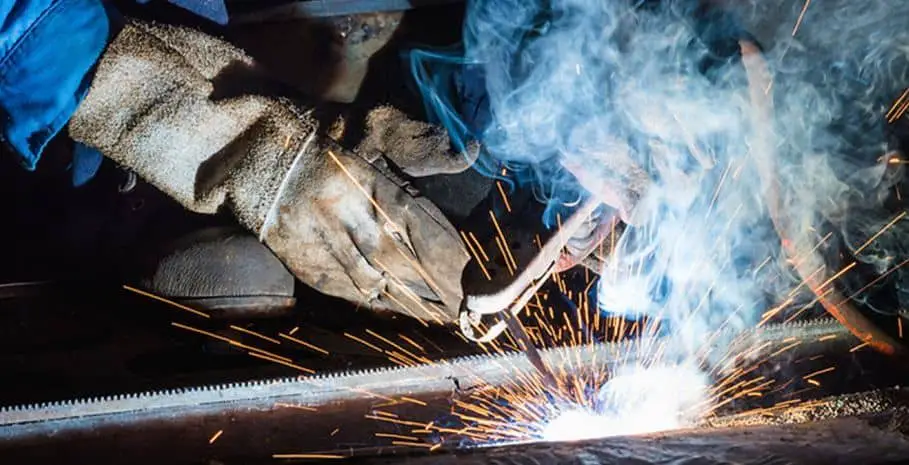Anyone who begins welding eventually wonders why the rod adheres to the workpiece while stick welding. This can cause a lot of inconvenience and can result in poor looking welds. This is something that is unavoidable when you are first starting out.
But don’t be concerned, it happens to the best of welders, and there are several reasons why your welding rod may cling to the metal, but if you keep a few things in mind, the odds of this happening are greatly decreased.
Welding rod tends to stick because the arc’s heat is insufficient to prevent fusing of the molten rod and the pool. The major explanations are low amperage settings or an arc length that is too short.
I know it can get extremely irritating when you try to pull off an aesthetically pleasing weld only to have it destroyed by spatter all over the place owing to the rod clinging to the metal.
So, here are a few reasons why this continues to happen.
1.) When the arc length is short
The arc length is the distance between the electrode’s tip and the base metal’s surface. It is also the time it takes for an electric arc to form.
If the electrode is placed too close to the base metal, it will become connected to it.
Similarly, if the electrode is moved too far away, the arc will be dissipated. As a result, it is necessary to maintain a specified optimal arc length.
2.) Low current configurations
As previously stated, welding rod clings to metal mostly owing to the low applied current value. It signifies that the amperage is high enough to melt the electrode tip but not high enough to cause an arc.
3.) A dirty metal surface
If the surface of the base metal is sufficiently dirty or rusted, striking the arc becomes difficult. Even if you manage to keep an arc going, the welding electrode will cling to the base metal at regular intervals.
Because voltage is constant, an increase in resistance results in a proportionate decrease in current. The rusted surface raises the resistance of our circuit, reducing the amount of electricity flowing.
4.) Incorrect amperage setting
It’s also possible that the amperage settings are too low for the thickness of the material.
In many circumstances, just adjusting the welding settings will suffice. Sticking, on the other hand, may signal a more significant problem with your equipment or setup.
5.) Inadequate flux quality
Sticking issues might also be caused by a lack of flux coating. Remember that the melting temperature of flux is always lower than that of the base metal.
It signifies that the flux is already liquid before the base metal begins to melt. If your flux coating is inadequate, it may fall off the rod and create a molten lump, causing the welding rod to become stuck to the base metal.
6.) Improper electrode selection
Welding rods come in a variety of shapes and sizes, each with its own set of applications and advantages. Some rods only operate in DC, while others may work in both AC and DC.
A thick rod used to weld thin sheets might also cause electrode sticking.
7.) When the open circuit voltage is low
If your machine’s OCV (Open Circuit Voltage) is too low, striking the arc becomes problematic. At low OCV, the arc fades and you’re more likely to stick the electrode while attempting to strike the spark again.
8.) Surface heat and material thickness
Sticking issues can also occur while welding on a thick piece of metal if you do not have a suitable power source or torch cable length.
This issue develops because as the weld pool goes deeper, it becomes more difficult for the heat to disperse into the surrounding base metal.
See also: Can You Touch The Rod When Stick Welding?
Here we give you some tips as to what you can do if the welding rod sticks.
First of all, there’s no need to freak out if your welding rod sticks to the metal. If the electrode becomes securely bonded to the metal, it will not operate. In that situation, you must quickly turn off the welder and break the rod free of the metal.
Another way is to push the stinger’s level to release the rod. This way, you can get rid of it without causing too much damage to the flux at the tip.
However, there will be a brief arc between the rod and the stinger, scarring the stinger.
If you use this rod with a bare metal tip for the second time, you will almost certainly end up sticking it.
To avoid this, cut the rod at the spot where the flux has dropped off using pliers and you’re ready to go again.
It’s now time to discover some important stick welding strategies to assist you avoid welding rod sticking issues:
How to prevent welding rod sticking to metal?
1.) While using the right rod size, keep the electrode and surface clean.
Before you begin, check sure your electrodes are not corroded or rusted. Try rubbing the flux off the rod with your fingertips.
If the flux easily slips off the rod, it indicates that the quality is poor, and the electrode will be more sticky. At all costs, avoid using these low-quality rods for a better experience.
If the weld has to be consistent, choose a bigger rod since larger rods have the highest deposit rate. Similarly, depending on the type of the weld, you must determine which size electrode to utilise.
Before welding, be careful to clean the metal’s surface of any rust, moisture, oil, or other contaminants.
See also: What is the Easiest Welding Rod to Use?
2.) Use the proper arc hitting method.
When hitting an arc, electrode sticking is more common. It takes weeks or months of practice to master the art of arc striking.
The dragging method (also known as the hitting method) and the tapping method are the two most frequent arc striking methods.
3.) Select an acceptable arc length.
Once you’ve established a steady arc, strive to keep an acceptable gap between the rod tip and the base metal.
Try to keep the distance small, but avoid touching the metal. Also, if you extend the arc length too much, the metal will spatter all over the place.
4.) Select the appropriate current settings.
Check that you’re using the correct amperage value. Different varieties of electrode rods are intended to operate at varying amperage levels.
The appropriate amperage values should be decided by the electrode type and the nature of the weld.
See also: How Many Amps Does a 110V Welder Use?
5.) Select an appropriate electrode.
Thick electrodes are more difficult to grasp and are more likely to stick. If you are a newbie, it is recommended to start with a thin welding rod because they are very easy to handle.
6.) Maintain the right angle and speed of travel.
I’m sure you’re familiar with the fundamental welding positions by now. You must ensure that you are in a comfortable position to maintain the uniformity of the weld until the very end.
If you elevate your travel speed, you will have less penetration, and if you slow down, you will have shallow deep penetrations. As a result, attempt to strike a balance between them for a high-quality weld finish.
7.) Maintain a solid ground connection.
If the base metal is not properly connected to the ground, the overall resistance of your circuit will rise. A high resistance results in a low Open Circuit Voltage, making it harder to create an arc. Establish a solid ground connection. Also examine the ground wire for any defects.
If the terminal connections have become excessively rusted, cut the wire at both ends and make new connections.
Another thing to keep in mind is that depending on the application, you must ensure that all of the stick welding leads are correctly connected.
See also: Best Stick Welders for Beginners (Portable and Budget)
Conclusion
Sticking the rod is a common issue with the stick welding method. Welding with low amperage is the primary reason.
Then there’s not having a consistent arc length and utilising defective rods or rods that aren’t compatible with your welding machine. However, always remember that practice is what makes your welding better and better each day.








